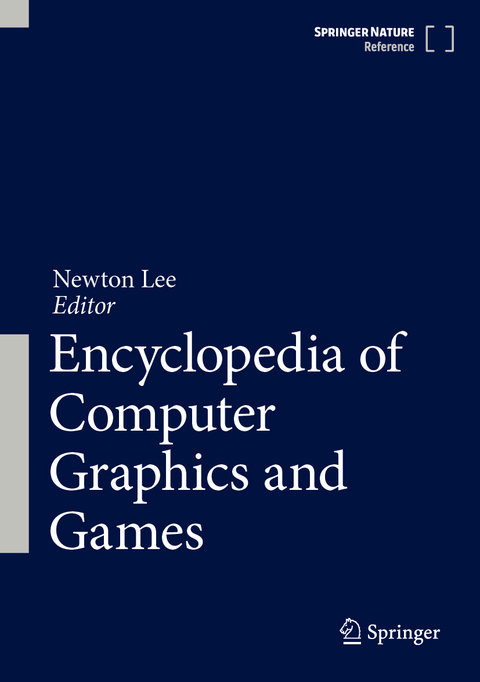
Encyclopedia of Computer Graphics and Games
Springer International Publishing
978-3-031-23159-9 (ISBN)
Editor
Newton Lee, Institute for Education, Research, and Scholarships, Los Angeles, CA, USA
Academic Co-Chairs
Shlomo Dubnov, Department of Music and Computer Science and Engineering, University of California San Diego, San Diego, CA, USA
Patrick C. K. Hung, University of Ontario Institute of Technology, Oshawa, ON, Canada
Jaci Lee Lederman, Vincennes University, Vincennes, IN, USA
Industry Co-Chairs
Shuichi Kurabayashi, Cygames, Inc. & Keio University, Kanagawa, Japan
Xiaomao Wu, Gritworld GmbH, Frankfurt am Main, Hessen, Germany
Editorial Board Members
Leigh Achterbosch, School of Science, Engineering, IT and Physical Sciences, Federation University Australia Mt Helen, Ballarat, VIC, Australia
Ramazan S. Aygun, Department of Computer Science, Kennesaw State University, Marietta, GA, USA
Barbaros Bostan, BUG Game Lab, Bahçesehir University (BAU), Istanbul, Turkey
Anthony L. Brooks, Aalborg University, Aalborg, Denmark
Guven Catak, BUG Game Lab, Bahçesehir University (BAU), Istanbul, Turkey
Alvin Kok Chuen Chan, Cambridge Corporate University, Lucerne, Switzerland
Anirban Chowdhury, Department of User Experience and Interaction Design, School of Design (SoD), University of Petroleum and Energy Studies (UPES), Dehradun, Uttarakhand, India
Saverio Debernardis, Dipartimento di Meccanica, Matematica e Management, Politecnico di Bari, Bari, Italy
Abdennour El Rhalibi, Liverpool John Moores University, Liverpool, UK
Stefano Ferretti, Department of Computer Science and Engineering, University of Bologna, Bologna, Italy
Han Hu, School of Information and Electronics, Beijing Institute of Technology, Beijing, China
Ms. Susan Johnston, Select Services Films Inc., Los Angeles, CA, USA
Chris Joslin, Carleton University, Ottawa, Canada
Sicilia Ferreira Judice, Department of Computer Science, University of Calgary, Calgary, Canada
Hoshang Kolivand, Department Computer Science, Faculty of Engineering and Technology, Liverpool John Moores University, Liverpool, UK
Dario Maggiorini, Department of Computer Science, University of Milan, Milan, Italy
Tim McGraw, Purdue University, West Lafayette, IN, USA
George Papagiannakis, ORamaVR S.A., Heraklion, Greece; FORTH-ICS, Heraklion Greece University of Crete, Heraklion, Greece
Florian Richoux, Nantes Atlantic Computer Science Laboratory (LINA), Université de Nantes, Nantes, France
Andrea Sanna, Dipartimento di Automatica e Informatica, Politecnico di Torino, Turin, Italy
Yann Savoye, Institut fur Informatik, Innsbruck University, Innsbruck, Austria
Sercan Sengün, Wonsook Kim School of Art, Illinois State University, Normal, IL, USA
Ruck Thawonmas, Ritsumeikan University, Shiga, Japan
Vinesh Thiruchelvam, Asia Pacific University of Technology & Innovation, Kuala Lumpur, Malaysia
Rojin Vishkaie, Amazon, Seattle, WA, USA
Duncan A. H. Williams, Digital Creativity Labs, Department of Computer Science, University of York, York, UK
Sai-Keung Wong, National Chiao Tun
Editor-In-Chief: Newton Lee, Newton Lee Laboratories, LLC and Institute for Education, Research, and ScholarshipsNiels Christian Nilsson, Aalborg University Copenhagen, København, SV, Denmark
B-Splines.- Constrained Edges and Delaunay Triangulation.- Delaunay Triangulation.- Modeling and Mesh Processing for Games.- Pencils of Spheres in the Minkowski-Lorentz Spaces.- Planetary Generation in Games.- Poisson-Disk Sampling: Theory and Applications.- Shape Deformation Models.- Sketch-Based Posing for 3D Animation.- Spheres, AABB, and OOBB as Bounding Volume Hierarchies.- The New Age of Procedural Texturing.- UV Map Generation on Triangular Mesh.- 3D Modelling Through Photogrammetry in Cultural Heritage.- 3D Printing, History of.- 3D Visualization Interface for Temporal Analysis of Social Media.- 3D-Rendered Images and Their Application in the Interior Design.- Deep Learning Algorithms for 3D Reconstruction.- Emotion-based Facial Recognition for Mental Health Status.- Tactile Visualization and 3D Printing for Education.- Technologies for the Design Review Process.- Artistic Data Visualization in the Making.- Computer Graphics, Video Games, and Gamification Impacting.- (Re)Habilitation, Healthcare, and Inclusive Well-Being.- Imagineering Ceramic Pottery Using Computer Graphics.- Universal Design, Design for All, Inclusive Design.- 3D Game Asset Generation of Historical Architecture Through Photogrammetry.- 3D Puzzle Games in Extended Reality Environments.- Academic and Video Game Industry "Divide".- Agile Mentality at Game Development.- Among Us and Its Popularity During COVID-19 Pandemic.- Analog Prototyping for Digital Game Design.- Animal Crossing: New Horizons and Its Popularity During COVID-19 Pandemic.- Animation Strategies for Game Design.- Builder Games.- Challenge-Based Learning in a Serious Global Game.- Comic Arts in Games, Asset Production, and Rendering.- Dark Souls Through the Lens of Essential Experience.- Dead Space Through the Lens of Resonance.- Defining Hands-On Practice as Game-Based Learning.- Defining Hands-on Practice as Game-based Learning: A Probable Concept on Information-based Image Development on Virtual Reality Platform.- Design Framework for Learning to Support Industry 4.0.- Design of Alienation in Video Games.- Domain-specific Choices Affecting Design Effort in Gamification.- Educational Game Abzû and the Lens of Fun Learning.- Effects of Digital Games on Mental Health of Gamers.- Emotion in Games.- Evolution of Video Games to Interactive Cinema.- Fuzzy Logic for Gaming and Entertainment Applications.- Game Behind Online Gaming.- Game Design and Emotions: Analysis Models.
| Erscheint lt. Verlag | 10.12.2023 |
|---|---|
| Zusatzinfo | LIV, 2115 p. 906 illus., 780 illus. in color. In 3 volumes, not available separately. |
| Verlagsort | Cham |
| Sprache | englisch |
| Maße | 178 x 254 mm |
| Gewicht | 5639 g |
| Themenwelt | Informatik ► Grafik / Design ► Digitale Bildverarbeitung |
| Mathematik / Informatik ► Informatik ► Software Entwicklung | |
| Informatik ► Theorie / Studium ► Künstliche Intelligenz / Robotik | |
| Schlagworte | Computer Games • Computer Graphics • Computer imaging • computer vision • pattern recognition |
| ISBN-10 | 3-031-23159-7 / 3031231597 |
| ISBN-13 | 978-3-031-23159-9 / 9783031231599 |
| Zustand | Neuware |
| Haben Sie eine Frage zum Produkt? |